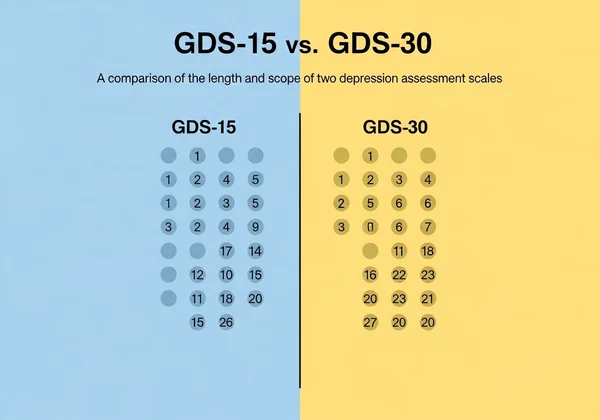Geriatric Depression Scale Score Interpretation Guide
Just received your Geriatric Depression Scale (GDS) score? Curious what it means for you or a loved one? This guide breaks down GDS score interpretation, from how it's scored to what different ranges indicate. Our aim is to give you clear, confident next steps for understanding and managing mental well-being. You can always begin your assessment at any time.

Understanding Geriatric Depression Scale Scoring
The Geriatric Depression Scale (GDS) is a widely recognized and scientifically validated tool designed to screen for depression in older adults. It simplifies the process by asking straightforward "yes" or "no" questions, making it accessible even for individuals with cognitive impairments. Understanding geriatric depression scale scoring is key to deciphering the insights it provides.
How the GDS Questions are Scored
The GDS consists of a series of questions about how an individual has felt over the past week. Each question is designed to assess symptoms commonly associated with depression in older adults. The scoring is quite direct: for most questions, a "yes" answer indicates a depressive symptom, while for others, a "no" answer does. For instance, answering "yes" to "Are you basically satisfied with your life?" might indicate a lack of satisfaction, but in the GDS context, for this specific question, "no" often points to a depressive symptom. The responses are tallied to produce a final score, reflecting the number of depressive indicators present. Our platform provides an easy-to-use online GDS tool for instant results.
Quick Look: GDS-15 vs. GDS-30 Scoring
The Geriatric Depression Scale comes in two primary versions: the GDS-30 (Long Form) and the GDS-15 (Short Form). Both are effective, but they differ in length and the range of symptoms they cover.
- GDS-30 (Long Form): This version contains 30 questions. The total score can range from 0 to 30. A higher score generally indicates more depressive symptoms.
- GDS-15 (Short Form): This is a more concise, 15-question version derived from the GDS-30, designed for quicker screening. The total score can range from 0 to 15. Similarly, a higher score suggests a greater likelihood of depressive symptoms.
While the number of questions differs, the underlying principle of GDS scoring remains consistent: each answer contributes to an overall assessment of potential depressive mood. Whether you choose the long or short form GDS, our platform helps you get your results quickly.

What a "Normal" GDS Score Signifies
Many individuals and caregivers wonder, "What is a normal score on the Geriatric Depression Scale?" It's a valid question, as understanding the lower score ranges can bring peace of mind or highlight areas needing subtle attention.
Understanding Low and Minimal Depression Ranges
For the GDS-15, scores typically fall into these categories:
- 0-4: This range usually indicates no or minimal signs of depression. A score within this bracket suggests that the individual's current mood assessment is generally healthy, and they are likely experiencing good emotional well-being.
- 5-9: This range suggests mild depression. While not severe, it indicates that some depressive symptoms are present and might warrant further observation or discussion with a healthcare professional.
For the GDS-30, the interpretations are scaled accordingly:
- 0-9: Similar to the 0-4 range in GDS-15, this indicates no or minimal depression.
- 10-19: This range suggests mild depression.
A low geriatric depression scale score is generally a positive indicator of current emotional health.
When Even a Low Score Warrants Attention
While a low normal GDS score is reassuring, it's essential to remember that the GDS is a screening tool. Even scores within the "normal" range shouldn't dismiss genuine concerns, especially if you or your loved one are experiencing subtle changes in mood or behavior. Factors like recent life events (e.g., loss of a spouse, relocation) or underlying overall health conditions can influence mood, even if not yet reflected in a higher score. It's crucial to consider the complete picture of an individual's well-being. Regular check-ins and open conversations about feelings are always beneficial, regardless of the score.
Interpreting a High GDS Score: What It Indicates
When a GDS score falls into the higher ranges, it's a sign that potential depressive symptoms are more pronounced. Understanding what a high score on the Geriatric Depression Scale mean is crucial for prompting appropriate next steps.
Decoding Mild, Moderate, and Severe Depression Ranges
Let's break down what higher scores typically indicate for both GDS versions:
For GDS-15:
- 10-15: This range suggests moderate to severe depression. A score in this category strongly indicates that the individual is experiencing significant depressive symptoms and should promptly seek professional evaluation.
For GDS-30:
- 20-30: This range, like the 10-15 on the GDS-15, indicates moderate to severe depression. It signifies a critical need for professional intervention and support.
These thresholds serve as crucial indicators for healthcare professionals and caregivers to identify individuals who may be struggling with their mental health and require targeted assistance. The GDS provides valuable insights, helping to guide the conversation toward necessary support. After you receive your GDS results, our platform provides immediate, clear interpretations.

Important Disclaimer: The GDS is a Screening Tool, Not a Diagnosis
It's crucial to remember that the Geriatric Depression Scale (GDS) is a screening tool, not a diagnostic instrument. A high score on the GDS indicates the likelihood of depression and suggests that a comprehensive clinical evaluation by a qualified medical professional is warranted. It does not, by itself, provide a definitive diagnosis of depression. Only a doctor or mental health specialist can diagnose depression and recommend a treatment plan. Our platform explicitly states this at every step, emphasizing responsible health management.
Beyond the Numbers: Context for Your GDS Result
Your GDS result is more than just a number. Understanding its true meaning requires looking at the bigger picture, as many contextual factors can influence your score.
Considering Life Events and Overall Health
An individual's GDS score is influenced by a myriad of factors. Recent life events such as the loss of a loved one, relocation, retirement, or significant changes in social support can profoundly impact mood and emotional resilience. Similarly, overall health conditions, including chronic illnesses, pain, medication side effects, or nutritional deficiencies, can mimic or contribute to depressive symptoms. For example, a person recovering from surgery might temporarily exhibit higher scores due to physical discomfort or reduced activity. When interpreting a GDS score, it's vital for caregivers and healthcare providers to consider these concurrent factors that might influence an individual's responses.
The Crucial Role of Professional Consultation
Regardless of your geriatric depression scale score, consulting with a qualified professional consultant is always the most responsible next step, especially if there are any concerns. A doctor, psychologist, or psychiatrist can conduct a thorough assessment, which includes not only the GDS but also a detailed medical history, physical examination, and discussion of symptoms. They can differentiate between clinical depression and temporary sadness or adjustment issues, ruling out other medical causes for symptoms. This personalized approach ensures accurate diagnosis and the development of an appropriate support or treatment plan. Utilizing a reliable online tool like the free geriatric depression scale we offer is an excellent first step, but it must be followed by professional guidance for any concerning results.

Empowering Your Next Steps with Your GDS Score
Understanding your GDS score interpretation is a powerful first step in addressing mental well-being for older adults. Whether the score indicates minimal symptoms or suggests a higher likelihood of depression, it serves as a valuable starting point for proactive health management. The Geriatric Depression Scale is an accessible and effective screening tool that empowers individuals, their families, and healthcare professionals to identify potential concerns early.
Remember, our platform offers a secure and user-friendly online GDS test with instant results. Beyond the score, we uniquely provide an optional AI-driven personalized report, transforming your numerical result into actionable insights and tailored recommendations. This advanced feature can offer a deeper understanding of your score, guiding you toward informed conversations with your doctor or mental health professional. Don't hesitate to take the GDS test online and gain immediate clarity. Empowered by your GDS score, taking these steps today can significantly enhance well-being for seniors.
Frequently Asked Questions About GDS Score Interpretation
How do you score the Geriatric Depression Scale?
The Geriatric Depression Scale is scored by assigning points (typically 1 point) for answers that indicate depressive symptoms. For most questions, a "yes" answer contributes to the score, while for others (e.g., "Are you happy most of the time?"), a "no" answer adds to the score. These points are then summed up to give a total score, which is interpreted based on established thresholds for minimal, mild, moderate, or severe depression. You can get an immediate score when you use our free GDS tool.
What is a normal score on the Geriatric Depression Scale?
For the GDS-15, a normal GDS score typically falls between 0 and 4, indicating no or minimal signs of depression. For the GDS-30, a normal range is generally considered to be 0-9. These ranges suggest that the individual is experiencing good mental well-being, though ongoing observation is always advisable.
What does a high score on the Geriatric Depression Scale mean?
A high GDS score suggests that an individual is experiencing a significant number of depressive symptoms. For the GDS-15, scores of 10-15 typically indicate moderate to severe depression. For the GDS-30, scores of 20-30 are indicative of moderate to severe depression. A high score strongly recommends that a professional medical evaluation be sought promptly.
Is the Geriatric Depression Scale a diagnostic tool?
No, the Geriatric Depression Scale is a screening tool, not a diagnostic one. It helps identify individuals who might be at risk for depression and should receive a more thorough clinical evaluation. A definitive diagnosis of depression can only be made by a qualified healthcare professional, such as a doctor or a mental health specialist, after a comprehensive assessment. Always consult a medical professional for a diagnosis.
Who can use the Geriatric Depression Scale?
The Geriatric Depression Scale is primarily designed for older adults (typically 55 and above) and can be used by the seniors themselves, family caregivers, and various healthcare professionals including doctors, nurses, and social workers. It is also a valuable assessment tool for staff in nursing homes or assisted living facilities for routine mental health screenings.